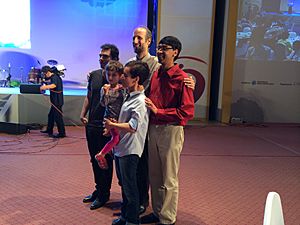Maryam Mirzakhani facts for kids
Quick facts for kids
Maryam Mirzakhani
|
|
|---|---|
| مریم میرزاخانی | |

Mirzakhani at the 2014 International Congress of Mathematicians in Seoul, where she received the Fields Medal.
|
|
| Born | 12 May 1977 22 Ordibehesht 1356 Tehran, Iran
|
| Died | 14 July 2017 (aged 40) Stanford, California, U.S.
|
| Education | Sharif University of Technology (BSc) Harvard University (PhD) |
| Spouse(s) |
Jan Vondrák
(m. 2008) |
| Children | 1 |
| Awards |
|
| Scientific career | |
| Fields | Mathematics |
| Institutions | |
| Thesis | Simple geodesics on hyperbolic surfaces and the volume of the moduli space of curves (2004) |
| Doctoral advisor | Curtis T. McMullen |
| Other academic advisors | Siavash Shahshahani, Ebadollah S. Mahmoodian |
Maryam Mirzakhani (Persian: مریم میرزاخانی, pronounced [mæɾˈjæm miːɾzɑːxɑːˈniː]; 12 May 1977 – 14 July 2017) was an amazing Iranian mathematician. She was a professor of mathematics at Stanford University in the United States. Her work explored complex ideas about shapes and spaces.
In 2005, she was named one of Popular Science magazine's "Brilliant 10" young minds. This award recognized her for pushing her field in new and exciting ways.
On August 13, 2014, Maryam Mirzakhani received the Fields Medal. This is the highest award a mathematician can get. She was the first Iranian and the first woman ever to win it. The award recognized her work on the geometry of curved surfaces.
Sadly, Maryam Mirzakhani passed away on July 14, 2017, at the age of 40. She had breast cancer.
Contents
Early Life and School
Maryam Mirzakhani was born in Tehran, Iran, on May 12, 1977. As a child, she went to Tehran Farzanegan School. This school is for students with special talents.
In high school, she won gold medals in the Iranian National Olympiad for mathematics. This meant she didn't have to take the national college entrance exam.
In 1994, Maryam became the first Iranian girl to win a gold medal at the International Mathematical Olympiad in Hong Kong. She scored almost perfectly. The next year, in Toronto, she scored a perfect score and won her second gold medal. She was the first Iranian to do this.
Later, she wrote a book called Elementary Number Theory, Challenging Problems. She wrote it with her friend, Roya Beheshti Zavareh. They were the first women to compete in the Iranian National Mathematical Olympiad.
In 1998, Maryam was in a bus accident that was a national tragedy in Iran. The bus fell off a cliff, and several students died. Maryam was one of the few who survived.
In 1999, she earned her bachelor's degree in mathematics from Sharif University of Technology. She was recognized for finding a simpler way to prove a math theorem. Then, she moved to the United States. She earned her PhD in 2004 from Harvard University. Her advisor was Curtis T. McMullen, who also won a Fields Medal. People at Harvard said she was very determined and always asked questions. She even took her class notes in Persian, her native language.
Her Career
After getting her PhD, Maryam Mirzakhani became a research fellow at the Clay Mathematics Institute in 2004. She also became a professor at Princeton University. In 2009, she joined Stanford University as a professor.
What She Studied
Maryam Mirzakhani made important discoveries about moduli spaces of Riemann surfaces. These are complex mathematical ideas about how shapes can change.
Her early work helped count special "straight lines" on curved surfaces. These lines are called geodesics. Imagine drawing the shortest path between two points on a curved surface, like the Earth. That's a geodesic. She focused on geodesics that form closed loops and don't cross themselves.
Before her work, mathematicians knew how many closed geodesics there were. But they didn't know how to count the simple closed ones. Maryam's PhD thesis in 2004 solved this problem. She showed that the number of these simple loops grows in a predictable way.
She solved this by connecting it to how you measure volumes in a special space called moduli space. This space helps mathematicians understand different ways to draw complex shapes. Her work led to new ways to calculate these volumes.
Later, she studied how these shapes change over time, which is called Teichmüller dynamics. She proved a long-standing idea about how these changes behave. She showed that a process called "earthquake flow" on these surfaces is ergodic. This means that over time, the process will visit every part of the space.
In 2014, Maryam Mirzakhani worked with Alex Eskin and Amir Mohammadi. They showed that certain complex paths in moduli space are surprisingly regular. This was a big surprise because these paths were thought to be more random. Their discovery was like finding order in a very complex system.
Winning the Fields Medal

Maryam Mirzakhani received the Fields Medal in 2014. This top award recognized her amazing work on the geometry of Riemann surfaces. She received the medal in Seoul on August 13 at the International Congress of Mathematicians.
The president of Iran, Hassan Rouhani, congratulated her on this huge achievement.
Her Personal Life
In 2008, Maryam Mirzakhani married Jan Vondrák. He is a computer scientist and mathematician from the Czech Republic. They had one daughter. Maryam lived in Palo Alto, California.
Maryam described herself as a "slow" mathematician. She believed you had to put in a lot of effort to truly see the beauty in math. When she worked on problems, she would draw doodles on paper. She would then write mathematical formulas around her drawings. Her daughter even said her mother's work looked like "painting."
Her Legacy
Maryam Mirzakhani was diagnosed with breast cancer in 2013. The cancer spread, and she passed away on July 14, 2017, at the age of 40.
Many people, including Iranian President Hassan Rouhani, shared their sadness and praised her scientific achievements. President Rouhani said her brilliance showed the great will of Iranian women and young people.
After her death, some Iranian newspapers published photos of Maryam without her hair covered. This was a big change from usual rules and was noticed around the world. Her death also led to discussions in Iran about citizenship for children of mixed-nationality parents.
Many tributes were shared after Maryam Mirzakhani's death. Because of efforts by the Iranian Mathematical Society, May 12, her birthday, is now International Women in Mathematics Day. This day honors her memory.
Several places have been named after her. In 2017, her old high school named its amphitheater and library after her. Sharif University of Technology, where she got her bachelor's degree, named its main math library after her. A conference hall in Isfahan was also named in her honor.
In 2014, students at the University of Oxford started the Mirzakhani Society. This group supports women and non-binary students studying math there. Maryam met with the society in 2015. In 2022, Oxford University started the Maryam Mirzakhani Scholarships. These scholarships help female math students, hoping to inspire future female Fields Medal winners.
In 2016, Maryam Mirzakhani became a member of the National Academy of Sciences in the United States. She was the first Iranian woman to join this important academy.
In 2018, a small satellite was launched and named in her honor. In 2019, the Breakthrough Prize Foundation created the Maryam Mirzakhani New Frontiers Prize. This $50,000 award is given each year to outstanding young women mathematicians.
In 2020, UN Women honored Maryam Mirzakhani as one of seven female scientists who have shaped the world. A documentary film about her, Secrets of the Surface: The Mathematical Vision of Maryam Mirzakhani, was also released in 2020.
The May 12 Initiative was created to celebrate women in mathematics. Many math organizations around the world coordinate events for this initiative.
Awards and Honors
- Gold medal at the International Mathematical Olympiad (Hong Kong 1994)
- Gold medal at the International Mathematical Olympiad (Canada 1995)
- IPM Fellowship (1995–1999)
- Merit Fellowship from Harvard University (2003)
- Harvard Junior Fellowship (2003)
- Clay Mathematics Institute Research Fellow (2004)
- AMS Blumenthal Award (2009)
- Invited to speak at the International Congress of Mathematicians (2010)
- The 2013 AMS Ruth Lyttle Satter Prize in Mathematics
- Simons Investigator Award (2013)
- Named one of Nature magazine's ten "people who mattered" (2014)
- Clay Research Award (2014)
- Fields Medal (2014)
- Elected foreign associate to the French Academy of Sciences (2015)
- Elected to the American Philosophical Society (2015)
- National Academy of Sciences (2016)
- Elected to the American Academy of Arts and Sciences (2017)
- Asteroid 321357 Mirzakhani was named in her memory.
See also
 In Spanish: Maryam Mirzajani para niños
In Spanish: Maryam Mirzajani para niños
- McShane's identity


